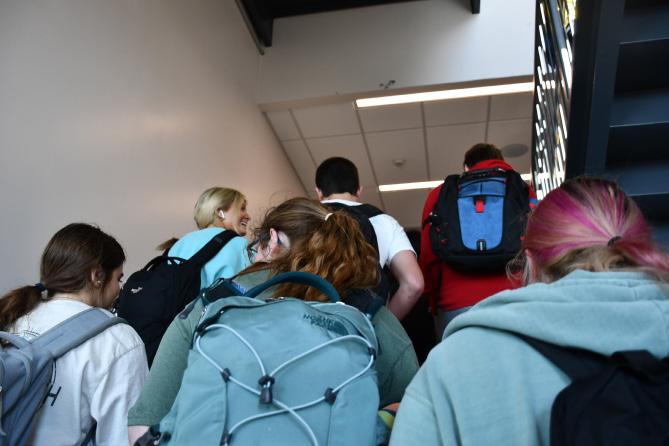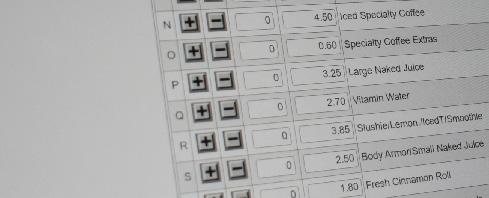PILOT








Cover Story
Digital Footprint - 6 & 7
News
Passing Period Problems - 4 & 5
Mouse Sightings - 8 & 9
Lunch Pricing Plans - 10 & 11
Elowyn Wells
Sam Elliott
Elizabeth Cleary
Natalie Van
Audrey Branding
Kyra Bast
Gavin Berry
Savannah Millheim
Lindsey Pham
Lavia Raof
Meadow Roy
Joey Haberberger
If stories from featured staff writers do not appear in the Pilot Newsmagazine, they can be found on lindberghlookup.com.
Pilot is a monthly newsmagazine published by students enrolled in the Pilot Publications class at Lindbergh High School, 5000 Lindbergh Boulevard, St. Louis, Missouri, 63126. The publications office is currently located in Room 401.
Opinions of Pilot writers or the Editorial Board are not reflective of the opinions of the staff as a whole, the Pilot, or the administration. The Pilot welcomes responses and letters to the editors. These may be submitted by email to lhspilot@ lindberghschools.ws or by signed letters brought to Room 401. The Pilot reserves the right to edit submissions as long as their original intent remains unaltered, and to refuse to print material for any reason the Editors in Chief and adviser deem inappropriate.
More information about our editorial policy can be found on lindberghlookup.com.

Edi tor-in-Chief Web Editor Co py Editor I nD e sign Editor S ta ff Writer S ta ff Writer S ta ff Writer S ta ff Writer S ta ff Writer S ta ff Writer S ta ff Writer Staff Writer 2 Contents
1.31.23
Hello Flyers! Thank you for reading another issue of the Pilot Newsmagazine. We’ve been hard at work in the newsroom to answer your pressing questions. In this issue, we are bringing to light the debate over passing period time, the impact of digital footprints, recent mice sightings, and the opinion of food pricing problems at LHS. For more stories and content not presented in our print edition, please visit lindberghlookup.com.
 Elowyn Wells Pilot Editor-in-Chief
Elowyn Wells Pilot Editor-in-Chief

A look into the controversial change in Lindbergh’s 2022-2023 daily bell schedule
The new building has come with some benefits and issues for students. Namely, after the geography of campus was expanded, the time between classes given for transitions was shortened causing some problems for many members of the student body.
With the full integration of students back on campus after a few years due to COVID-19 restrictions, student traffic appears to be more populated, especially with the continued addition of construction of campus buildings. There have been numerous complaints circulating within the student body about how inconvenient the shorter passing periods have become. Students say it is affecting them in ways such as being unable to get to class on time, use the restroom or interact with their friends.
“I think the biggest issue with the five minute period is going from the old to the new building,” said senior Micah Truelove-Herrick. “There’s major congestion, and most of the time I’m late to whatever class is in the old 300’s.”
As there is only one elevator available currently, students who use the elevator are finding it harder than normal to get to class on time.
“I feel super rushed in between classes... because our passing period time got shortened by 2 minutes.”
The results of a Google Form sent out to the student body about the passing period reported that of the 293 responses, 87.3% of students said they disliked the current transition time. Those who disliked the current time commented that the perfect amount of time to get between classes would be closer to six or seven minutes. A student, who wished to remain anonymous, gave their input on why they felt this way.
Freshman Violet Rizen said that the experience of her unique situation with transitioning between classes was unpleasant.
“I can never make it to class on time, and there are so many students in one hallway. It makes it so you can’t go through the doors,” Rizen said. “I can barely get to class in time even with the extra five minutes added onto the








“I feel super rushed in between classes, not only having super crowded stairwells and going between the new and old buildings, but also because our passing period time got shortened by 2 minutes. (That additional time) seems like it wouldn’t be much, but it really helped,” they said.“With the current passing period, we spend about 1-2 minutes of class time waiting for any “late” people to get to class anyway.”
While the greater majority of students stated a general disliking of the current passing period, there have reportedly been minimal complaints directed to administration regarding the current passing period time.

-LHS 10th Grader
Photo credit: Elowyn
was expanded, the time between classes given for transitions was shortened causing some problems for many members of the student body. With the full integration of students back on campus after a few years due to COVID-19 restrictions, student traffic appears to be more populated, especially with the continued addition of construction of campus buildings. There merous complaints circulating within the about how inconvenient the shorter passing have become. Students say it is affecting such as being unable to get to class on time, restroom or interact with their friends.
“I think the biggest issue with the five minute period is going from the old to the new building,” said senior Micah Truelove-Herrick.
Dr. Gregory Fick, the 12th grade principal, also stated that there were almost half as many tardy related offenses this semester compared to first semester last year, and minimal complaints have been made to administration about


“Last year, in term one, we had ninety-eight offenses total for the ninth grade, and for the 9th grade this term, we had fifty-three,” said Fick. “A fifty-percent decrease in referrals and consequences, which in normal times, would


Main Principal Dr. Cochran said there are currently
“I still believe nine times out of ten, five minutes is plenty of time to get to class on time. I also feel like our teachers are relatively flexible when it comes to tardies.” He added, “that is the message we’ve given to our teachers. If there is someone you know who is trying their best to get to class on time, we ask teachers to really be flexible with
Despite the complaints about the current schedule, Cochran stated that he believes this is a positive change that
“There will always be some students and teachers who want more, and so you have to make the best decision to maximize why we’re here, which is to learn,” he said.



1.31.23








Looking into the future, whether that involves getting a job or applying to college, your potential employers or admissions officers might be shocked to see your Harry Styles fanpage on Instagram, flashing over one thousand followers all invested in your next thirst-post over Harry’s abs. Collins Dictionary defines “digital footprint” as the information about a person that can be retrieved from the internet. In the hands of an employer or admissions officer, this information can either be beneficial or detrimental, making a well-curated online presence crucial to your future.
Katherine Keegan, a counselor at Lindbergh High School, has knowledge regarding the impact that a negative digital footprint holds. The denial from a job, or a college especially, is a big deal, and luckily, one that can be avoided. However, Keegan believes that most students are not aware of how their footprint affects their future, their ability to get into colleges and to be considered for other opportunities.
“Every student needs to think about that,” said Keegan. “Maybe it won’t affect college admissions, but if you’re applying for a competitive scholarship at a university then there’s a great chance that they will deep dive into your social media.”
Keegan feels that the number one mistake students make when posting on social media is not thinking before they post. College admissions officers and employers tend to look for negative or offensive content or posts wherein illegal activity is taking place.

“If you wouldn’t want your grandma to see it, you probably don’t want to post it.”
 - Katherine Keegan-
- Katherine Keegan-
“If you wouldn’t want your grandma to see it, you probably don’t want to post it,” offered Keegan.

According to Wink News, a local Florida news outlet, a teen’s college acceptance was denied after a social media post that targeted two people of color. The University of Florida rescinded their acceptance letter to this student, stating that while people may have the freedom of speech, there could be consequences derived from the things that individuals say or post.
 Information regarding social media guidelines for current and potential students found on the Washington University in St. Louis website.
Information regarding social media guidelines for current and potential students found on the Washington University in St. Louis website.
Similarly, PR Newswire in Chicago states that around 90% of employers look at candidates’ social media accounts, and 79% of those employers have turned away potential employees after viewing their accounts.
With countless horror stories demonstrating the downward spiral that results from a negative online presence, it is essential to create a positive image on any given social media account. Megan Manaj, a 12th grade student who has been accepted to Washington University in St. Louis, sheds some light on how to best do this.
“I would definitely say I just post socially acceptable things, in that sense. I don’t post anything that’s too controversial or too political, and then I also don’t post things in bad environments,” Manaj said. “I always keep things very clean and PG.”
Manaj has always been alert to the possibility of universities viewing her social accounts. She does believe, however, that many people are not mindful of their footprint, whether they simply don’t realize its effect or whether they just don’t care.

“For the most part, I would agree that my peers have positive digital footprints, but I would also say that some of my peers don’t care what they post online and will post things of them at parties,” Manaj commented.



Digital presence is very pressing in this day and age, with colleges and professional companies keeping an eye on hateful, immature or illegal content,

presentation becoming evident in students’ lives. In their eyes, having a social media presence that reflects your best self is essentially the same as attending a job interview showered, well prepared and in an ironed suit. As the future encroaches, thought must go into how you can best iron out the wrinkles in your digital footprint in order to ensure your success.
7 Cover Story 1.31.23
A group of students scroll on social media during lunch. Photo by Elizabeth ClearyAll you need to know about Lindbergh’s recent mice sightings



Room 333. What might seem like a regular classroom in the new building, amongst the other hundreds, has a secret hiding in its drawers. Well, multiple secrets. Mrs. Weitzel, teacher of the Social Studies department, first moved into the room during the start of the school year. She’d soon be a witness, and perhaps victim, to what the walls had been hiding: the mice. She’d started suspecting things when she saw various droppings in her class but, still unsure, called Mr. Tobias, also of the Social Studies department, and had some other colleagues come in and confirm her fears.
When she saw one firsthand, rummaging through the candy she’d kept in her desk, the situation became all too real.
“My first reaction was to run across the hallway,” Weitzel recalled of this direct confrontation.
Soon, she’d find herself having another encounter with a mouse in her cabinet across the room from her desk, and eventually capture it; adding into a total of two mice. These instances aren’t so bad when compared to her experiences in her old room where she said she saw mice quite frequently; however, these occurrences were the first time they’d actually gotten into her belongings.
So, why is this happening? It could be because of the newly-constructed building’s structural connection to the old one that’s currently under renovation.
“See, with the construction in the old building, I think it has moved some of these creatures into different places,” Weitzel said. “Or, when our things were packed up and moved here,
 Weitzel’s desk of which she first spotted a mouse rummaging through the drawer.
Weitzel’s desk of which she first spotted a mouse rummaging through the drawer.
Dr. Greg Fick, principal of the senior class, has heard of sightings elsewhere; one in the collaboration space, next to room 143, and in the area near the learning stairs by the elevator.

“With the cold weather, I imagine they’re moving into the old building that has holes and lots of spaces that they can go into,” Fick explained, “and then they’re mov ing into the warmer building.”
So, what’s the solution that’ll put an end to these confrontations? For Mrs. Weitzel, she resorted to using traps– both the glue traps that the school provides and ones for caged capture bought by teachers. When a mouse is caught, she calls a custodian that takes it away; she doesn’t know what happens to the mice after. No matter, the district can and has hired people in pest control, who can hopefully subside the issue until construction finishes this fall.
“That’s gonna be something that I guess will need to be ongoing to try to keep pests out of the building.” Fick said.
For a video of a sighting, visit lindberghlookup.com



In all, a total of three mice have been captured on the third floor of the new building according to Weitzel– but the sightings haven’t stopped there. Megan Krippner (12), spotted a mouse in a collaboration space (146) during an interview she had for her yearbook class. Having never seen anything like it, she started recording the
 The collaboration space (146) where Megan saw the mouse.
The collaboration space (146) where Megan saw the mouse.



Food for thought: would you go to a store without knowing the prices and proceed to buy items from that establishment? Many Lindbergh High School students are unaware of the fact that à la carte items are priced separately and are more expensive when not adding a fruit or vegetable and milk to their meals. The solution to clear the confusion on food pricing and inform students is to create a lunch system that offers transparency and clarification, aiming to stop students from going into a negative balance in their lunch accounts. Lindbergh High School has been under construction for the new school since 2019. Alongside the new building, Lindbergh and the Southwest Foodservice Excellence Program (SFE) have changed how students grab lunch throughout the building. In the new building, there are a total of three Flyer Cafes as well as the North cafeteria and South cafeteria that serve as a grab-and-go system for students to buy food during power lunch. With a variety of options for different foods at different locations, problems do arise. While our food service works hard to overcome these hardships, the number of students that attend Lindbergh, and that buy lunch, open the opportunity to let things fall into the cracks. One of the main issues that have arisen is the lack of transparency when it comes to school lunch prices. Most students are unaware that getting a full meal with all of the food groups is cheaper than if they just bought à la carte items. For example, students that buy the whole meal will pay $3.30 compared to a student who got an à la carte item, like Bosco sticks, which cost $4.50.
Jenny Schira, the Administrative Assistant to the Food Service Director at Lindbergh, sheds light on how important it is for certain students to buy a whole meal and how if protocols are ignored it will not only cost the students, but the school as well. She states, “When a representative from the Missouri Department of Elementary and Secondary Education will be here for next year to assess us, he or she will come down or stand behind a cashier. They will watch as kids come through the lunch lines and monitor what’s on their trays. If they don’t have all three of those components present and we claim it as a meal, we’ll be fined. So, we have to make sure that when students are buying their lunch that we are being very observant as to what the kids are having and we’re charging them appropriately.”
The SFE runs an offer vs. serve program, which enables students to have a variety of options. They must follow the meal standards provided by the USDA (United States Department of Agriculture) and DESE (Missouri Department of Elementary and Secondary Education) for appropriate serving sizes and restrictions to take part in this program. The school is monitored by DESE and must abide by all of its requirements when it comes to the standard of food and service. Every three to four years, DESE makes an assessment of the food service at Lindbergh. If the school is not following the set federally required rules, the school will receive an audit fine under the pretense that they are not following all of the necessary regulations. To help the food service staff struggle less with the audit, students should get the full intended meal that follows the USDA standards, containing all of the daily food groups.
Students need to know they are being charged more
Natalie Van InDesign-Editor
It is essential to keep students informed on what foods they are required to get and how much they are buying them for in order to avoid issues such as going over their lunch balance, being fined and helping the school’s food service avoid becoming affected by the audit. The school does provide the necessary resources to obtain this information, but there is confusion regarding communication and many students don’t know where to look for prices or understand the importance of the resources offered, like the online menu for Lindbergh lunches. To locate the daily menus and their prices, going onto the website, Nutrislice, and typing in their school’s name will lead the students to the breakfast and lunch menus for the week.





There are questions that come up like, why don’t the students just simply ask about the prices? Realistically, a student could ask, but they wouldn’t want to have that task every single day. No one is pointing the blame at Lindbergh High School or the students, but simple changes, like making menu pricing obvious to students, will keep them aware of what lunch requirements they should follow and make students understand the importance of the resources that are available, which is the best solution to tackle issues with school lunch.







